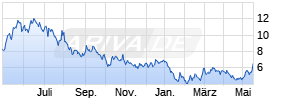
Patriot Discovers New High-Grade Zone at the CV13 Spodumene Pegmatite, Corvette Property, Quebec, Canada
PR Newswire
VANCOUVER, BC, Oct. 18, 2023
VANCOUVER, BC, Oct. 18, 2023 /PRNewswire/ - October 19, 2023 – Sydney, Australia
Highlights
- Discovery of new high-grade zone (with sample ranges including 3 – 5% Li2O) near-surface at the CV13 Spodumene Pegmatite.
- 12.7 m at 2.46% Li2O (73.3 m to 86.0 m), including 7.6 m at 3.82% Li2O (CV23–191).
- 8.0 m at 2.86% Li2O (57.2 m to 65.2 m), including 4.3 m at 5.03% Li2O (CV23–195).
- 10.2 m at 2.70% Li2O (56.3 m to 66.5 m), including 5.8 m at 4.48% Li2O (CV23–198)
- 10.7 m at 2.79% Li2O (67.0 m to 77.7 m), including 7.3 m at 3.94% Li2O (CV23–200)
- The CV13 Spodumene Pegmatite trend extends over an approximate 2.3 km strike length through multiple outcrop exposures, of which, approximately 1.1 km has now been traced continuously by drilling – remains open along strike at both ends and to depth.
- With significant mineralization now delineated further west at CV5 and at CV13, there are now several options for the mining starter pit.
- Company continues to drill westward from CV5 towards CV13 to test potential connectivity.
- Thirty-seven (37) drill holes, totalling approximately 7,300 m, have been completed in 2023 through October 9 at the CV13 Spodumene Pegmatite.
- Additional rig now coring for a total of eight (8) drill rigs currently active at site – four (4) at CV5, three (3) at CV13, and one (1) at CV9. Drilling is anticipated to ramp up further after the holidays with ten (10) drill rigs anticipated by mid January 2024.
Darren L. Smith, Company Vice President of Exploration, comments: "Drilling at CV13 has progressed steadily since our recommencement of activities in August, with results continuing to support the interpretation of an extensive, shallow-dipping and near-surface spodumene pegmatite dyke. The discovery announced today of a +3% Li2O high-grade zone at CV13, now traced over multiple drill holes, is reminiscent of the high-grade Nova Zone at CV5. As we continue to close the distance between CV5 and CV13 through drilling, this newly discovered high-grade zone at CV13, coupled with the large spodumene crystals observed (up to 1.3 m in drill core), supports the interpretation that both share the same "plumbing" system.
Further highlights include;
- Metallurgy results to date provide a strong indication that material from both the CV13 Spodumene Pegmatite and CV5 Spodumene Pegmatite may be processed jointly using the same design criteria and flowsheet, and therefore, processable at the same plant.
- Fe2O3 contents of <0.70% consistently demonstrated in final spodumene concentrates produced from both the CV5 and CV13 pegmatites following heavy liquid separation (HLS) and magnetic separation at the bench scale.
- Assays are pending for the vast majority of drill holes completed over the summer-fall program. The Company will update the market as material sets of assays return from the labs. The Company expects to provide an updated mineral resource estimate in mid-2024.
Patriot Battery Metals Inc. (the "Company" or "Patriot") (TSXV: PMET) (ASX: PMT) (OTCQX: PMETF) (FSE: R9GA) is pleased to announce core assays for the first series of drill holes completed at the CV13 Spodumene Pegmatite as part of the ongoing 2023 summer-fall drill program being completed at its wholly owned Corvette Property (the "Property" or "Project"), located in the Eeyou Istchee James Bay region of Quebec. At the Property, the CV13 Spodumene Pegmatite is located approximately 3.15 km along strike to the southwest of the CV5 Spodumene Pegmatite. The CV5 Spodumene Pegmatite, with a maiden mineral resource estimate of 109.2 Mt at 1.42% Li2O inferred1, is situated approximately 13.5 km south of the regional and all–weather Trans-Taiga Road and powerline infrastructure.
Core assay results from the first series of drill holes completed this year at the CV13 Spodumene Pegmatite have returned the highest-grade assays reported to date (Figure 1 and Figure 2, Table 1). Specifically, these drill holes have identified a newly discovered high-grade lithium zone – 12.7 m at 2.46% Li2O, including 7.6 m at 3.82% Li2O (CV23-191), 8.0 m at 2.86% Li2O, including 4.3 m at 5.03% Li2O (CV23-195), 10.2 m at 2.70% Li2O, including 5.8 m at 4.48% Li2O (CV23-198), and 10.7 m at 2.79% Li2O, including 7.3 m at 3.94% Li2O (CV23-200). Additionally, drill hole CV23-195 returned two (2) samples assaying greater than 6% Li2O, including 1.2 m at 6.41% Li2O.
The new high-grade zone at CV13 is located near-surface (~40-50 m vertical depth), and remains open in multiple directions with a current strike length of approximately 170 m. Additionally, in an adjacent drill hole (CV23-271), situated approximately 60 m to the west, an approximate 1.3 m long, inclusion-free, and cream-white spodumene crystal was intersected (Figure 3) – assays pending – and may represent an extension of this high-grade zone. Such high grades of lithium are not typical in Li-Cs-Ta ("LCT") pegmatite systems and this, coupled with the very large sizes of spodumene crystals, highlight the unique and world-class nature of the LCT pegmatite system at Corvette.
ARIVA.DE Börsen-Geflüster
Kurse
 |
 |
The discovery of a new and near-surface high-grade zone at CV13 provides multiple opportunities, that the Company will investigate, for defining an initial production location(s) (i.e., mining starter pit) that is complimentary to the CV5 mineral resource. With significant mineralization now delineated further west at CV5 and at CV13, lake development at CV5 could come later in the mine schedule.
The principal spodumene pegmatite dyke at CV13 (the "upper" dyke) is geologically modelled to be shallowly dipping to the north, covering an extensive area, and remains open along strike at both ends and to depth. A cross-section of the western portion of the CV13 Spodumene Pegmatite's current geological model is presented in Figure 4. The mineralized trend at CV13 extends for approximately 2.3 km as defined by outcrop and drilling through 2022. The drill holes completed in 2023 along this trend have now confirmed a continuous, variably mineralized spodumene pegmatite extending along at least 1.1 km of this trend and remains open.
Pegmatite intersections of the upper dyke are up to 26 m (core length) over the thirty-seven (37) drill holes (~7,300 m) completed in 2023 through October 9. A "lower" pegmatite dyke, which also has a shallow and northerly dip, has been tested in multiple drill holes in 2023; however, remains of secondary focus at this time due to more variability in thickness and mineralization.
The very high grades of lithium in drill core returned from CV13 to date, coupled with the large spodumene crystals as well as similar textures and gangue mineralogy as CV5, supports the interpretation that both CV13 and CV5 share the same plumbing system and may potentially form one continuous pegmatite body subsurface. However, a significant amount of drill testing remains to be completed along this corridor to confirm this interpretation. Through September 18, 2023, drilling had closed the gap between the CV13 and CV5 spodumene pegmatites to approximately 3.15 km (Figure 5, see news release dated September 24, 2023).
A heavy liquid separation (HLS) test program assessed the liberation and recovery characteristics of spodumene at different locations along the collective ~2.3-km trend that defines the CV13 Pegmatite (see news release dated July 4, 2023). The testwork returned very positive results with lithium recoveries ranging from 67% to 77% at an interpolated spodumene concentrate grade of 6.00% Li2O and <0.70% Fe2O3. Recoveries also remained strong on the lower grade samples, which is a testament to the coarse-grained nature of the spodumene making it more amenable to liberation. Collectively, the preliminary HLS results strongly indicate that a dense media separation (DMS) only operation at CV13 is applicable.
To date, the metallurgical data collected from CV5 and CV13 is highly encouraging and demonstrates that a DMS only flowsheet is applicable to both pegmatites. Further, the data suggests that both pegmatites could be jointly crushed and feed the same process plant, while maintaining high recoveries into a marketable spodumene concentrate of +5.5% Li2O.
Due to the road closures in western parts of the Eeyou Istchee James Bay extending significantly past the date in which the Company was able to re-commence drill operations at the Property, the delivery of drill core samples to the laboratory was significantly delayed. However, core samples from a large number of drill holes have now arrived at the laboratory with processing underway. Results will be reported in batches as received.
| 1 The CV5 mineral resource estimate (109.2 Mt at 1.42% Li2O and 160 ppm Ta2O5 inferred) is reported at a cut-off grade of 0.40% Li2O with effective date of June 25, 2023 (through drill hole CV23-190). Mineral resources are not mineral reserves as they do not have demonstrated economic viability. |
A Quality Assurance / Quality Control protocol following industry best practices was incorporated into the program and included systematic insertion of quartz blanks and certified reference materials into sample batches at a rate of approximately 5%. Additionally, analysis of pulp-split and coarse-split sample duplicates were completed to assess analytical precision at different stages of the laboratory preparation process, and external (secondary) laboratory pulp-split duplicates were prepared at the primary lab for subsequent check analysis and validation.
All core samples collected were shipped to SGS Canada's laboratory in Val-d'Or, QC, for sample preparation (code PRP89 special) which includes drying at 105°C, crush to 90% passing 2 mm, riffle split 250 g, and pulverize 85% passing 75 microns. The pulps were shipped by air to SGS Canada's laboratory in Burnaby, BC, where the samples were homogenized and subsequently analyzed for multi-element (including Li and Ta) using sodium peroxide fusion with ICP-AES/MS finish (codes GE_ICP91A50 and GE_IMS91A50).
The CV Lithium Trend is an emerging spodumene pegmatite district discovered by the Company in 2017 and is interpreted to span more than 50 kilometres across the Corvette Property. The core area includes the approximate 4.35 km long CV5 Spodumene Pegmatite, which hosts a maiden mineral resource estimate of 109.2 Mt at 1.42% Li2O inferred1.
To date, seven (7) distinct clusters of lithium pegmatite have been discovered across the Corvette Property – CV4, CV5, CV8, CV9, CV10, CV12, and CV13. Given the proximity of some pegmatite outcrops to each other, as well as the shallow till cover in the area, it is probable that some of the outcrops may reflect a discontinuous surface exposure of a single, larger pegmatite "outcrop" subsurface. Further, the high number of well-mineralized pegmatites along the trend indicate a strong potential for a series of relatively closely spaced/stacked, sub-parallel, and sizable spodumene-bearing pegmatite bodies, with significant lateral and depth extent, to be present.
The information in this news release that relates to exploration results for the Corvette Property is based on, and fairly represents, information compiled by Mr. Darren L. Smith, M.Sc., P.Geo., who is a Qualified Person as defined by National Instrument 43-101, and member in good standing with the Ordre des Géologues du Québec (Geologist Permit number 01968), and with the Association of Professional Engineers and Geoscientists of Alberta (member number 87868). Mr. Smith has reviewed and approved the technical information in this news release.
Mr. Smith is Vice President of Exploration for Patriot Battery Metals Inc. and holds common shares and options in the Company.
Mr. Smith has sufficient experience, which is relevant to the style of mineralization, type of deposit under consideration, and to the activities being undertaken to qualify as a Competent Person as described by the Australasian Code for Reporting of Exploration Results, Mineral Resources and Ore Reserves (the JORC Code). Mr. Smith consents to the inclusion in this news release of the matters based on his information in the form and context in which it appears.
Patriot Battery Metals Inc. is a hard-rock lithium exploration company focused on advancing its district-scale 100% owned Corvette Property located in the Eeyou Istchee James Bay region of Quebec, Canada, and proximal to regional road and powerline infrastructure. The Corvette Property hosts the CV5 Spodumene Pegmatite with a maiden mineral resource estimate of 109.2 Mt at 1.42% Li2O inferred1 and ranks as the largest lithium pegmatite resource in the Americas based on contained lithium carbonate equivalent (LCE), and one of the top 10 largest lithium pegmatite resources in the world. Additionally, the Corvette Property hosts multiple other spodumene pegmatite clusters that remain to be drill tested, as well as more than 20 km of prospective trend that remain to be assessed.
| 1 The CV5 mineral resource estimate (109.2 Mt at 1.42% Li2O and 160 ppm Ta2O5 inferred) is reported at a cut-off grade of 0.40% Li2O with effective date of June 25, 2023 (through drill hole CV23-190). Mineral resources are not mineral reserves as they do not have demonstrated economic viability. |
For further information, please contact us at info@patriotbatterymetals.com or by calling +1 (604) 279-8709, or visit www.patriotbatterymetals.com. Please also refer to the Company's continuous disclosure filings, available under its profile at www.sedarplus.ca and www.asx.com.au, for available exploration data.
This news release has been approved by the Board of Directors.
"BLAIR WAY"
Blair Way, President, CEO, & Director
This news release contains "forward-looking information" or "forward-looking statements" within the meaning of applicable securities laws and other statements that are not historical facts. Forward-looking statements are included to provide information about management's current expectations and plans that allows investors and others to have a better understanding of the Company's business plans and financial performance and condition.
All statements, other than statements of historical fact included in this news release, regarding the Company's strategy, future operations, financial position, prospects, plans and objectives of management are forward-looking statements that involve risks and uncertainties. Forward-looking statements are typically identified by words such as "plan", "expect", "estimate", "intend", "anticipate", "believe", or variations of such words and phrases or statements that certain actions, events or results "may", "could", "would", "might" or "will" be taken, occur or be achieved. In particular and without limitation, this news release contains forward-looking statements pertaining to the summer-fall drilling program and the completion and publication of Company's technical report comprising the maiden mineral resource estimate in respect of the Corvette Property.
Forward-looking information is based upon certain assumptions and other important factors that, if untrue, could cause the actual results, performance or achievements of the Company to be materially different from future results, performance or achievements expressed or implied by such information or statements. There can be no assurance that such information or statements will prove to be accurate. Key assumptions upon which the Company's forward-looking information is based include the total funding required to complete the development of the Company's lithium mineral project at the Corvette Property (the "Corvette Project"), including the drilling program.
Readers are cautioned that the foregoing list is not exhaustive of all factors and assumptions which may have been used. Forward-looking statements are also subject to risks and uncertainties facing the Company's business, any of which could have a material adverse effect on the Company's business, financial condition, results of operations and growth prospects. Some of the risks the Company faces and the uncertainties that could cause actual results to differ materially from those expressed in the forward-looking statements include, among others, the ability to execute on plans relating to the Company's Corvette Project, including the timing thereof. In addition, readers are directed to carefully review the detailed risk discussion in the Company's most recent Annual Information Form filed on SEDAR+, which discussion is incorporated by reference in this news release, for a fuller understanding of the risks and uncertainties that affect the Company's business and operations.
Although the Company believes its expectations are based upon reasonable assumptions and has attempted to identify important factors that could cause actual actions, events or results to differ materially from those described in forward-looking statements, there may be other factors that cause actions, events or results not to be as anticipated, estimated or intended. There can be no assurance that forward-looking information will prove to be accurate, as actual results and future events could differ materially from those anticipated in such information. As such, these risks are not exhaustive; however, they should be considered carefully. If any of these risks or uncertainties materialize, actual results may vary materially from those anticipated in the forward-looking statements found herein. Due to the risks, uncertainties and assumptions inherent in forward-looking statements, readers should not place undue reliance on forward-looking statements.
Forward-looking statements contained herein are presented for the purpose of assisting investors in understanding the Company's business plans, financial performance and condition and may not be appropriate for other purposes.
The forward-looking statements contained herein are made only as of the date hereof. The Company disclaims any intention or obligation to update or revise any forward-looking statements, whether as a result of new information, future events or otherwise, except to the extent required by applicable law. The Company qualifies all of its forward-looking statements by these cautionary statements.
The mineral resource estimate in this release was reported by the Company in accordance with ASX Listing Rule 5.8 on July 31, 2023. The Company confirms it is not aware of any new information or data that materially affects the information included in the previous announcements and that all material assumptions and technical parameters underpinning the estimates in the previous announcements continue to apply and have not materially changed.
Appendix 1 – JORC Code 2012 Table 1 information required by ASX Listing Rule 5.8.2
Section 1 – Sampling Techniques and Data
| Criteria | JORC Code explanation | Commentary |
| Sampling |
|
|
| Drilling techniques |
|
|
| Drill sample |
|
|
| Logging |
|
|
| Sub-sampling |
|
|
| Quality of assay |
|
|
| Verification of |
|
|
| Location of data |
|
|
| Data spacing and |
|
|
| Orientation of data |
|
|
| Sample security |
|
|
| Audits or reviews |
|
|
Section 2 – Reporting of Exploration Results
| Criteria | JORC Code explanation | Commentary |
| Mineral tenement status |
|
|
| Exploration done |
|
Werbung Mehr Nachrichten zur Pennymac Mortgage Investment Aktie kostenlos abonnieren
E-Mail-Adresse
Bitte überprüfe deine die E-Mail-Adresse.
Benachrichtigungen von ARIVA.DE (Mit der Bestellung akzeptierst du die Datenschutzhinweise) -1  Vielen Dank, dass du dich für unseren Newsletter angemeldet hast. Du erhältst in Kürze eine E-Mail mit einem Aktivierungslink. Hinweis: ARIVA.DE veröffentlicht in dieser Rubrik Analysen, Kolumnen und Nachrichten aus verschiedenen Quellen. Die ARIVA.DE AG ist nicht verantwortlich für Inhalte, die erkennbar von Dritten in den „News“-Bereich dieser Webseite eingestellt worden sind, und macht sich diese nicht zu Eigen. Diese Inhalte sind insbesondere durch eine entsprechende „von“-Kennzeichnung unterhalb der Artikelüberschrift und/oder durch den Link „Um den vollständigen Artikel zu lesen, klicken Sie bitte hier.“ erkennbar; verantwortlich für diese Inhalte ist allein der genannte Dritte. |



